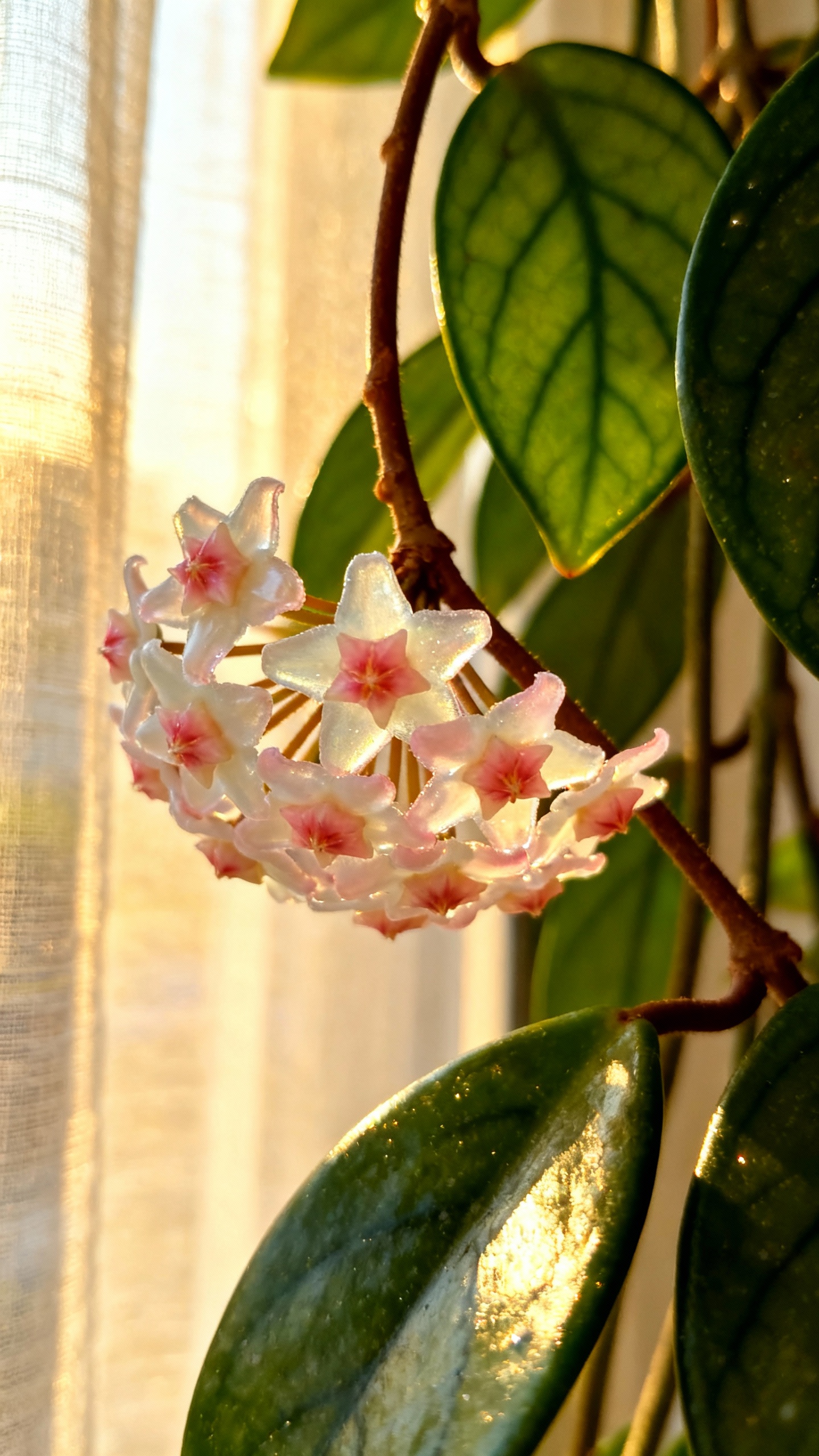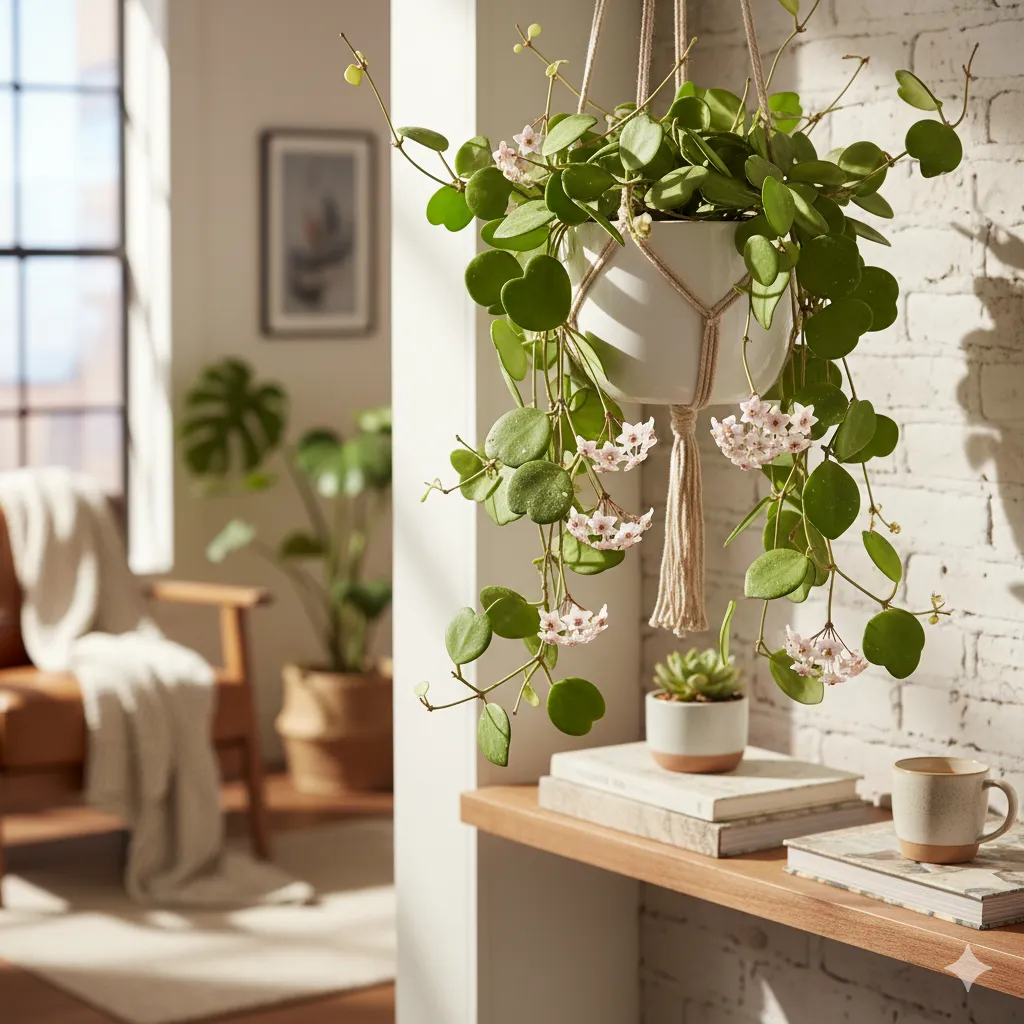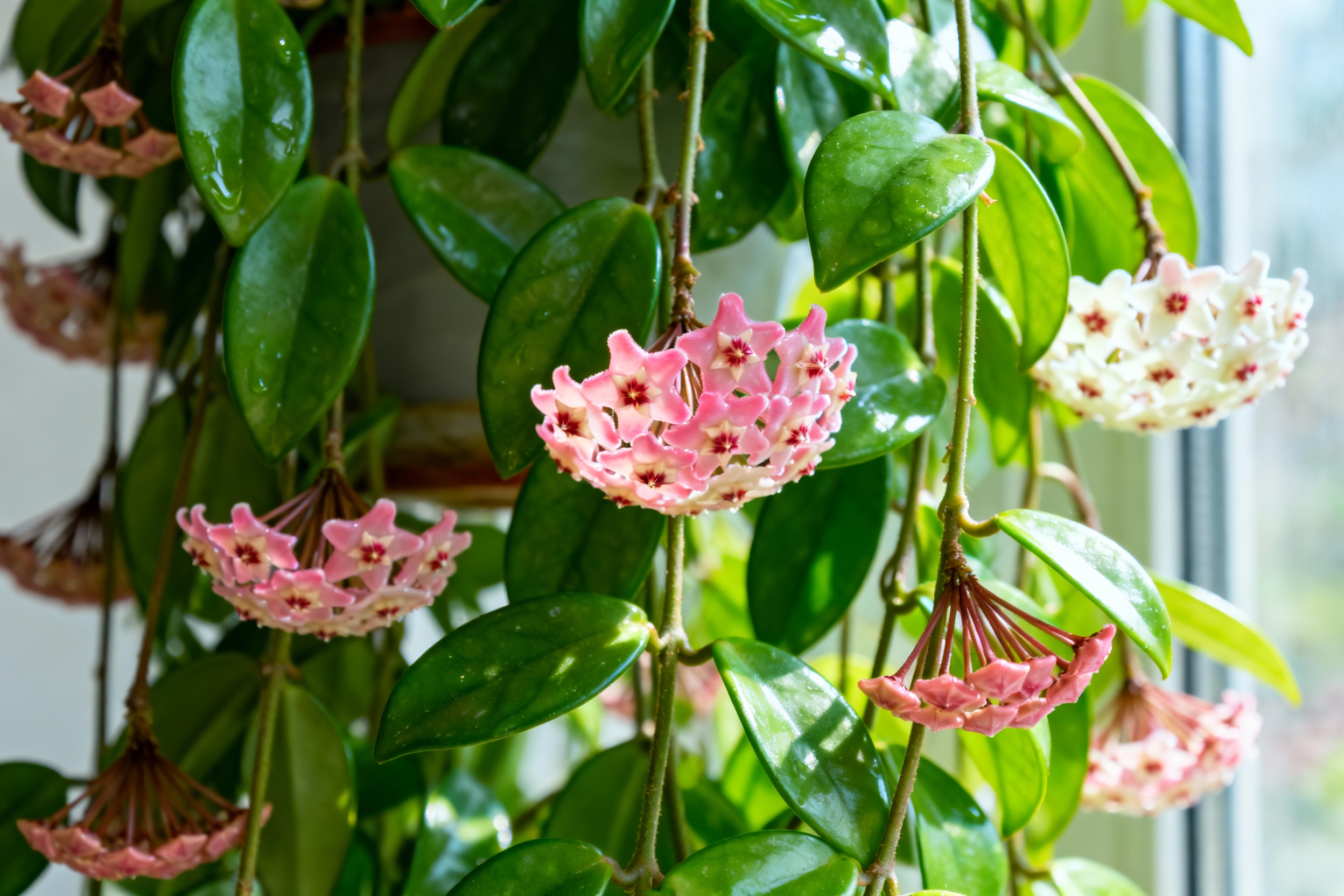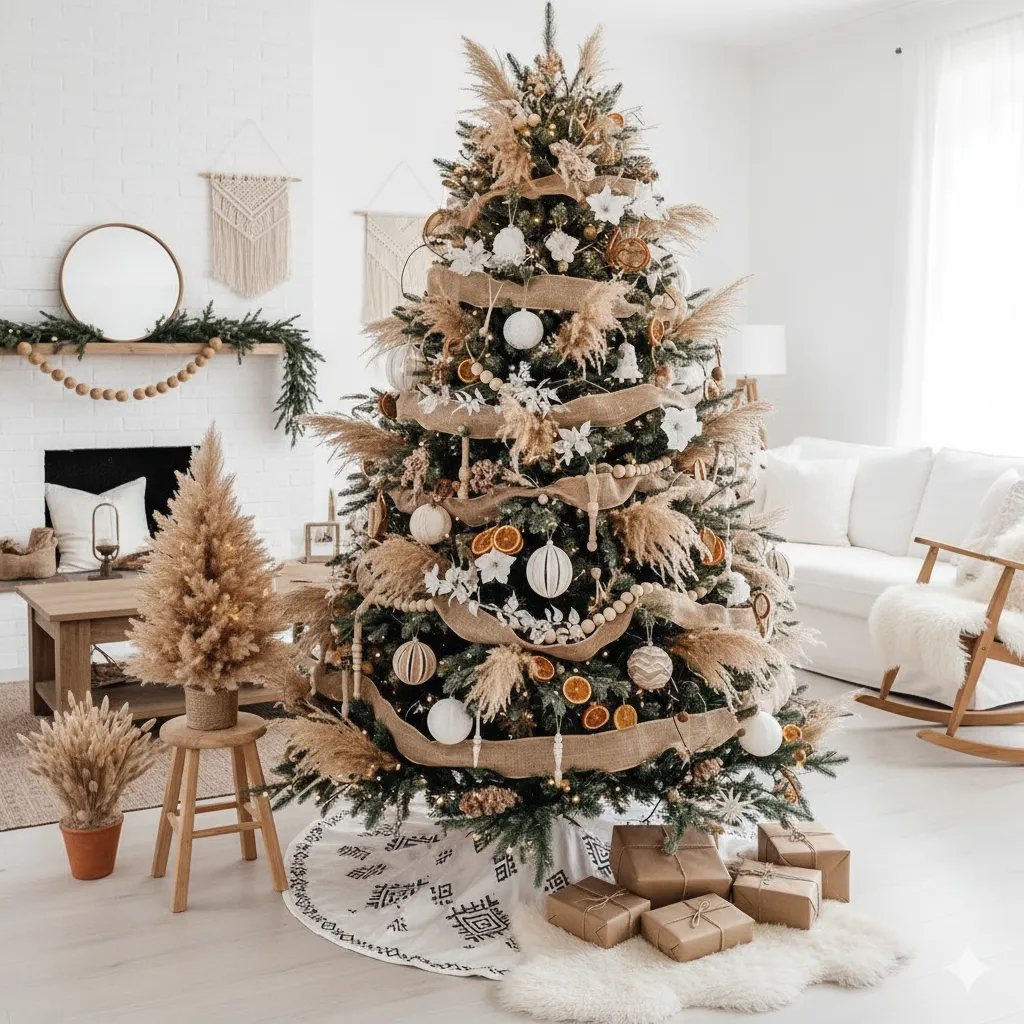Hoyas reward a little nerdy care with outrageous starry blooms and glossy vines that look fake in the best way. If your wax plant feels stuck, stingy, or just “meh,” a few smart tweaks can flip the switch. Let’s slip into plant-propagator mode and talk practical hacks that actually work.
Yes, you can keep your Hoya alive, grow it fast, and coax it to flower without turning your home into a greenhouse lab.
Light: The Bloom Switch You’re Probably Ignoring

You want flowers? Give your Hoya more light—like, a lot more than you think. Most Hoyas thrive in bright, indirect light with some gentle morning sun.
South or east windows = chef’s kiss. Quick hacks:
- Use a sheer curtain for south-facing windows to avoid leaf scorch, but still deliver strong light.
- Grow lights work if your space runs dim. Aim for 12–14 hours daily with a full-spectrum LED.
- Color tells the truth: deep green leaves often signal not enough light; slightly sun-kissed leaves mean “just right.”
Sun-stress for Flowers (The Good Kind)
Gently increase light over 2–3 weeks to “sun-stress” certain varieties (Hoya carnosa, Hoya krimson queen). Slight pinking or speckling means you found the sweet spot.
Crispy brown edges? Dial it back.
Watering: The Lazy Method That Saves Your Plants
Overwatering kills Hoyas way faster than underwatering. They store moisture in their leaves and don’t enjoy wet feet. Lazy-but-expert routine:
- Bottom water when possible: set the pot in a tray of water for 10–20 minutes.
It hydrates roots evenly and keeps leaves dry.
- Use the knuckle test: water only when the top 1–2 inches feel dry, or when leaves just begin to soften.
- Winter slowdown: cut watering frequency in half when growth stalls.
Leaf Clues You Can Trust
Wrinkly, soft leaves = thirsty. Yellowing, mushy leaves = too wet. Crisp edges with a hard pot of soil?
Hydrophobic mix—soak thoroughly and add more chunky material next repot.

Soil & Potting Mix: Give Those Roots Some Air
Hoyas crave air around their roots. Dense, peaty soil suffocates them. You want a chunky, fast-draining mix that dries quickly. Easy recipe (by volume):
- 40% high-quality potting mix
- 30% orchid bark
- 20% perlite or pumice
- 10% horticultural charcoal or coco chips
Bonus hacks:
- Clear nursery pots inside decorative planters let you spot root health and moisture.
- Under-pot intentionally: slightly snug pots encourage blooms and prevent soggy soil—Hoyas actually like being cozy.
- Repot rarely: every 2–3 years, only when roots circle heavily or mix collapses.
Self-Watering?
Proceed With Caution
Self-watering pots can work if you use a chunky mix and let the reservoir dry out between fills. IMO, only try them once you know your plant’s thirst pattern.
Humidity & Airflow: The “Why Won’t It Flower?” Fix
Hoyas don’t demand rainforest humidity, but they love it. 50–60% humidity boosts new growth and blooms, especially for thinner-leaved species. Make it happen:
- Group plants to create a microclimate—free humidity bump.
- Humidifier over pebble trays: pebble trays help a bit, but humidifiers actually move the needle.
- Airflow matters: a small fan on low keeps leaves dry and prevents pest drama.
Temperature Sweet Spot
Keep it between 65–80°F (18–27°C). Cool nights can cue flowering for some species, but don’t dip below 55°F or you’ll get drama and leaf drop.
Fertilizer & Bloom Fuel: Don’t Starve Your Vines
You don’t need fancy potions, but you should feed.
A well-fed Hoya grows faster and blooms more. Feeding plan (FYI, simple wins):
- Balanced liquid fertilizer at 1/4–1/2 strength every 2–4 weeks during spring and summer.
- Bloom nudge: switch to a formula with a bit more phosphorus when peduncles form (not mandatory, but it helps).
- Don’t fertilize dry soil: water first, then feed to avoid root burn.
Calcium & Micronutrients
Some Hoyas appreciate added calcium/magnesium. A Cal-Mag supplement once a month can green up leaves and prevent weird deficiencies. Don’t overdo it—more isn’t better, it’s just salty.
Training, Pruning, and The Peduncle Rule
Hoyas want to climb or cascade.
Give them a structure and they’ll reward you with tidy growth and more blooms. Training hacks:
- Use a hoop or moss-free trellis: Hoyas don’t need wet moss. Plastic or bamboo is fine and cleaner.
- Pin and loop vines back toward the pot to encourage branching.
- Snip smart: prune only long, bare vines to push side shoots.
Golden rule: Never cut peduncles (those little spurs where flowers bloom). Hoyas rebloom from the same peduncle multiple times.
Trim them and you reset the clock—ask me how I know.
Propagation Shortcut
Got leggy vines? Propagate and pot them back in with the mother plant for a fuller look. Take 2–3 node cuttings, root in water or perlite, then plant into your chunky mix.
Keep warm and bright, and you’ll have a lush pot fast.
Pest-Proofing & Common Oopsies
Hoyas don’t attract drama… until they do. Mealybugs love the nooks and leaf joints. Spider mites show up during dry spells.
Catch issues early. Simple protocol:
- Inspect weekly—flip leaves, check nodes, scan peduncles.
- Shower the plant with lukewarm water to knock pests off.
- Follow with insecticidal soap or neem every 7–10 days for 3 cycles if you spot anything.
Common mistakes (and fixes):
- Cutting peduncles: don’t do it. Leaves? Fine.
Peduncles? No.
- Low light + heavy watering: recipe for root rot. Pick one: more light or less water.
Preferably both.
- Repotting too often: Hoyas like tight shoes. Chill.
Hoya-Specific Quirks Worth Knowing
Not all Hoyas act the same. Some climb, some trail, some pretend they’re succulents. Quick vibes by type:
- Hoya carnosa and cultivars: forgiving, bloom with decent light, tolerate mild neglect.
- Hoya pubicalyx: fast and showy, loves trellises, easy bloomer.
- Hoya kerrii: cute heart leaves, slower, needs bright light to do more than just sit.
- Thin-leaf types (e.g., Hoya linearis): appreciate higher humidity and gentler watering.
- Fuzzy-leaf types (e.g., Hoya bella, Hoya multiflora): slightly more water-hungry; don’t let them bone-dry for long.
Bloom Patience (And a Reality Check)
Some Hoyas take a year or three to flower.
Age, light, and root maturity matter. If your plant looks healthy but refuses to bloom, keep the light high, pot snug, and fertilize lightly. Then wait.
IMO, Hoyas test patience on purpose.
FAQs
Why does my Hoya drop buds before they open?
Bud blast usually means inconsistent watering, sudden light changes, or low humidity. Keep conditions steady when buds form—no relocating, no skipped waterings, and bump humidity to 50–60%. A gentle fan helps too.
Can I grow a Hoya in low light?
It will live, but it won’t thrive.
Expect slower growth, fewer vines, and basically zero blooms. Add a small grow light if your window can’t deliver bright indirect light.
Do Hoyas like to be rootbound?
They tolerate it well and sometimes bloom better in tighter pots. Don’t suffocate them, but choose a pot just 1–2 inches wider than the root ball.
Focus on aeration over pot size.
How often should I mist my Hoya?
You don’t need to mist daily. It raises humidity for, like, two minutes. If you enjoy misting, go for it, but a humidifier or grouping plants makes a real difference without wetting the leaves constantly.
What’s the best trellis for Hoyas?
Simple hoops, ladders, or stakes work.
Avoid constantly damp moss poles for Hoyas—they don’t need the extra moisture at their stems. Use soft ties and guide vines gently to encourage branching.
Can I prune a Hoya right after flowering?
Yes—just avoid cutting the peduncles. Trim long bare stems and tip-prune to encourage fuller growth.
Feed lightly afterward to support new shoots.
Wrap-Up: Your Wax Plant Glow-Up
Give your Hoya bright light, a chunky mix, and a sane watering routine, and it will pay you back with glossy vines and clusters of fragrant waxy stars. Train it, don’t baby it, and never cut the peduncles. Keep the vibe steady, feed modestly, and add a little humidity.
Do that, and your Hoya goes from “cute leaf collection” to “how is this even real?” FYI, that’s the exact reaction we’re going for.


